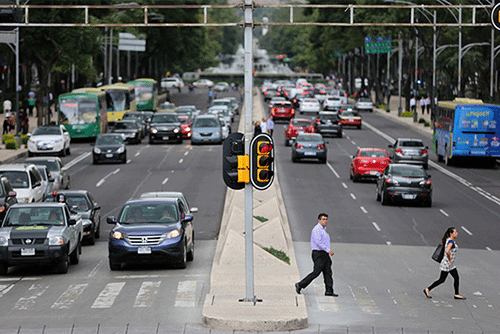Harvard Gazette: The Makeover of Mexico City
By Corydon Ireland, Harvard Gazette
MEXICO CITY — In a poem, Octavio Paz called the vast, colorful, ever-expanding metropolis of his birth “a paradise of cages.”
It is, after all, a city where tenuous but imaginative informal housing sprouts amid the grid of formal architecture, a city where shanties, wash lines, and water tanks pop up on the rooftops of high-rent buildings. In greater Mexico City, home to 22 million people and covering 3,700 square miles, more than half of the architecture is built without regulations.
Paz also wrote of a Mexico City that “in its circular fever repeats and repeats.” That image applies to the city’s traffic. In the central, historical heart called the distrito federal, or D.F. (pronounced “day-efay”), 9 million residents of 16 boroughs live in a 570-square-mile tangle of traffic. It’s riven day and night by cars, trucks, and microbuses — more than 3 million vehicles, a third of them more than 20 years old. For commuters on the outskirts of the D.F., congestion is so bad that the daily trip to work can take up to three hours.
The same traffic contributes to air pollution. (“I am surrounded by city,” Paz wrote plaintively in another poem. “I lack air.”) In 1992, the United Nations called Mexico City’s air quality the planet’s worst, so bad that flying birds, overwhelmed, would fall dead from the sky. By 1998, the U.N. called Mexico City the world’s most dangerous city for children’s health.
Thanks to stringent regulatory reform in the last two decades, the situation has dramatically improved. Air quality in Mexico City now resembles that in Los Angeles: not wonderful, but not catastrophic. New laws have reduced the city’s once prodigiously dirty industrial footprint, which had included lead smelters.
The metropolitan area (41 municipalities outside the D.F. in the states of Mexico and Hidalgo) is in the Valley of Mexico. It constitutes the heart of a nation where “geography has been destiny,” said Jose Castillo, M.Arch. ’95, D.Des.’00. Castillo is a Mexico City architect and a lecturer at Harvard’s Graduate School of Design (GSD).
That destiny includes volcanic mountains, which make the mile-high city dramatically beautiful, but also create air inversions that cloak it in trapped pollutants.
And that destiny is both wet and fragile. Hundreds of years ago, Mexico City was a soggy maze of 45 rivers and five lakes atop an ancient volcano. The lakes mostly have been filled in, and the rivers have been covered by roadways. But subsoils still wiggle like Jell-O when an earthquake hits. (The biggest recent ones rattled through in 1985 and 1957.) In the same soils, pipework supplies city water, 35 percent of which is lost in transit.
Read the entire article in the Harvard Gazette.

